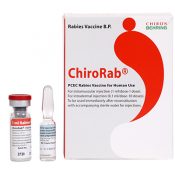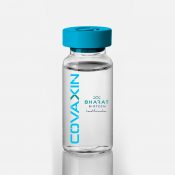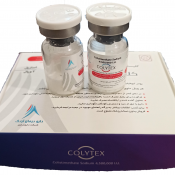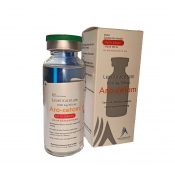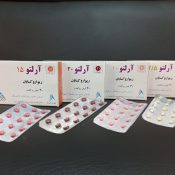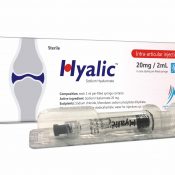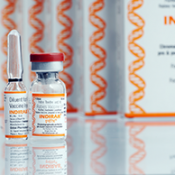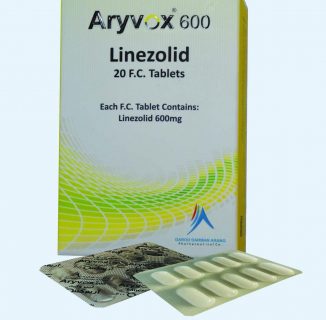
Linezolid, ARYVOX
ARYVOX® tablets for oral administration contain 400 mg or 600 mg linezolid as film-coated tablets. Inactive ingredients are corn starch, microcrystalline cellulose, hydroxypropyl cellulose, sodium starch glycolate, magnesium stearate, hypromellose, polyethylene glycol and titanium dioxide.
INDICATION
Linezolid is an oxazolidinone antibacterial used for the treatment of Gram-positive infections of the skin and respiratory tract, including those due to vancomycin-resistant enterococci (VRE) and methicillin-resistant Staphylococcus aureus (MRSA). It is less active against Gram-negative bacteria.
MECHANISM OF ACTION
Linezolid inhibits bacterial protein synthesis by interfering with translation. Linezolid binds to a site on the bacterial 23S ribosomal RNA of the 50S subunit; this action prevents the formation of a functional 70S initiation complex, an essential step in the bacterial translation process. Without proper protein production, susceptible bacteria cannot multiply. The action of linezolid is considered to be bacteriostatic against staphylococci and enterococci. Linezolid appears to be bacteriocidal against the majority of streptococcal strains tested.
PHARMACOKINETICS
Linezolid is rapidly and extensively absorbed after oral dosing. Maximum plasma concentrations are reached approximately 1 to 2 hours after dosing, and the absolute bioavailability is approximately 100%. It is about 31% bound to plasma proteins. Linezolid is reported to be distributed into bone, fat, lungs, muscle, skin blister fluids, and into the CSF. It is primarily metabolized by oxidation two main inactive metabolites: the aminoethoxyacetic acid metabolite (A), and the hydroxyethyl glycine metabolite (B). About 40% of a dose is excreted in the urine as metabolite B, 30% as linezolid, and 10% as metabolite A. small amounts of metabolites are excreted in the faeces. The elimination half-life of linezolid is about 5 to 7 hours. Children exhibit more rapid clearance of linezolid than adults; half-life is reported to range from about 2 to 4 hours, increasing with age. Formation of metabolite A is presumed to be formed via an enzymatic pathway whereas metabolite B is mediated by a non- enzymatic chemical oxidation mechanism in vitro. In vitro studies have demonstrated that linezolid is minimally metabolized and may be mediated by human cytochrome P450. However, the metabolic pathway of linezolid is not fully understood.
DRUG INTERACTIONS
Linezolid is a reversible, nonselective MAOI and therefore has the potential to interact with adrenergic and serotonergic drugs.
Gentamicin: Pharmacokinetics of linezolid and gentamicin not affected if the drugs are used concomitantly.
Ampicillin: In vitro evidence of additive or indifferent antibacterial effects.
Aztreonam: Pharmacokinetics of linezolid and aztreonam not affected if the drugs are used concomitantly. In vitro evidence of additive or indifferent antibacterial effects. In vitro evidence of additive or indifferent antibacterial effects.
MAO inhibitors: Potential pharmacologic interaction.
Phenytoin: Pharmacokinetic interaction unlikely.
Rifampin: Decreased peak plasma concentration and AUC of linezolid.
Serotonergic drugs: Postmarketing case reports of serotonin syndrome in patients who received linezolid concurrently with or shortly after discontinuation of serotonergic agents, including SSRIs (e.g., citalopram, fluoxetine, paroxetine, sertraline).
Sympathomimetic agents: Potential pharmacologic interaction (enhanced vasopressor effects) with sympathomimetic agents, vasopressor agents, or dopaminergic agents.
Vancomycin: in vitro evidence of additive or indifferent antibacterial effects.
CONTRAINDICATIONS / WARNINGS
Known hypersensitivity to linezolid or any ingredient in the formulation.
Should not be used in patients who are receiving (or have received within the last 2 weeks) drugs that inhibit MAO A or B (e.g., isocarboxazid, phenelzine).
Unless patients are monitored for potential increases in blood pressure, should not be used in patients with uncontrolled hypertension, pheochromocytoma, or thyrotoxicosis or in patients receiving directly or indirectly acting sympathomimetic agents (e.g., pseudoephedrine), vasopressive agents (e.g., epinephrine, norepinephrine), or dopaminergic agents (e.g., dopamine, dobutamine).
Unless patients are carefully observed for signs and/or symptoms of serotonin syndrome, should not be used in patients with carcinoid syndrome and/or in patients receiving SSRIs, tricyclic antidepressants, serotonin 5-HT receptor agonists (triptans), meperidine, or buspirone.
PRECAUTIONS
• Lactic acidosis, characterized by recurrent nausea and vomiting, has been reported. Patients who develop recurrent nausea and vomiting, unexplained acidosis, or a low bicarbonate concentration while receiving linezolid should undergo immediate medical evaluation.
• Serotonin syndrome reported in patients receiving linezolid and serotonergic drugs. If administration of linezolid and a serotonergic drug is considered clinically appropriate, monitor the patient closely for signs and symptoms of serotonin syndrome (e.g., cognitive dysfunction,hyperpyrexia,¬¬¬¬-hyperreflexia, incoordination).
• Peripheral and optic neuropathy, sometimes progressing to loss of vision, reported; these events have occurred principally in patients receiving the drug for>28 days.
• Linezolid should be used with caution in patients with a history of a seizure disorder. Seizures have been reported with linezolid and in some of the cases, patients had a history of seizures or risk factors for seizures.
• Monitor CBCs weekly during linezolid therapy, especially in those receiving the drug for >2 weeks and in those who have preexisting myelosuppression, are receiving concomitant drugs associated with bone marrow suppression, or have a chronic infection that was or is being treated with concomitant anti-infective therapy
• Use of linezolid for empiric treatment of CNS infections not recommended.
• Linezolid is not approved by the FDA for treatment of catheter-related bacteremia or catheter-site infections and is not approved for treatment of gram-negative bacterial infections.
• Linezolid may make you feel dizzy or experience problems with your vision. If this happens, do not drive or operate any machinery
• Avoid eating large amounts of mature cheese, yeast extracts, or soya bean extracts e.g. soya sauce. This is because this medicine may react with a substance called tyramine which is naturally present in some foods to cause an increase in your blood pressure.
DOSAGE & ADMINISTRATION
It is given, orally in a usual adult dose of 600 mg every 12 hours for 10 to 14 days; treatment for up to 28 days
may be necessary if there is vancomycin resistance.
In uncomplicated skin and skin structure infections an oral dose of 400 mg every 12 hours for 10 to 14 days is usually sufficient.
-If you forget to take linezolid,¬¬ use the missed dose as soon as you remember. Skip the missed dose if it is almost time for your next scheduled dose.
Do not take a double dose to make up for a forgotten dose
-If you take more linezolid than you shoul¬d¬ tell your doctor or pharmacist immediately.
ADVERSE REACTIONS
The adverse effects most frequently reported in patients given linezolid include diarrhoea, nausea and vomiting, metallic taste, headache, insomnia, constipation, rashes, dizziness, fever, oral and vaginal candidiasis, and abnormal liver function tests. Superficial tooth discoloration and tongue discoloration have been reported with the use of linezolid.
Lactic acidosis has been reported. Convulsions have also been reported in patients treated with linezolid. In some of these cases, a history of seizures or risk factors for seizures was reported. There have been rare reports of bullous skin eruptions including Stevens-Johnson syndrome.
Peripheral and optic neuropathy, sometimes progressing to loss of vision, have occurred rarely, mainly in patients given linezolid for more than 28 days. Visual blurring has been reported in some patients given less than 28 days of treatment. Reversible myelosuppression including anaemia, leucopenia, pancytopenia and, in particular, thrombocytopenia has been reported.
PREGNANCY
Linezolid is classified in FDA pregnancy risk category C. The effect of Linezolid in pregnant women is not known. Therefore it should not be taken in pregnancy unless advised by your doctor.
BREAST-FEEDING
Use linezolid with caution in breast-feeding females. Linezolid and its metabolites are excreted into the breast milk in rats at concentrations similar to maternal rat plasma. It is likely that linezolid is excreted in human milk.
HOW SUPPLIED
ARYVOX® Tablets are available as follows:
400 mg (20 tablets per box)
600 mg (20 tablets per box)
Storage of ARYVOX® tablets
Store below 30ºC. Protect from light and moisture.
Keep this medicine out of the sight and reach of children.
Do not throw away any medicines via wastewater or household waste. Ask your pharmacist how to throw away medicines you no longer use. These measures will help protect the environment.
Do not use this medicine after the expiry date.
